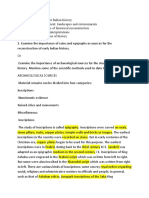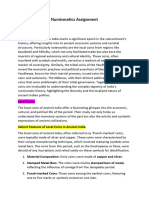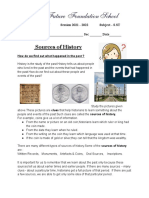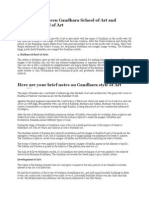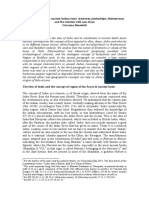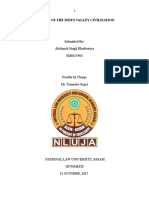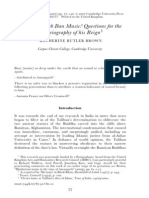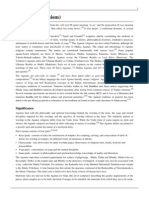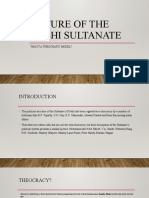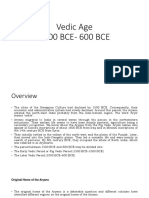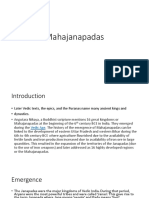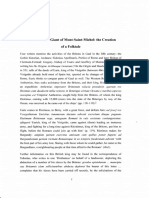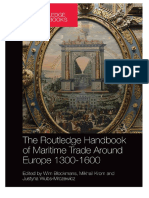Professional Documents
Culture Documents
Discuss The Importance of Archaeological Sources in Reconstructing The History of Ancient India.
Discuss The Importance of Archaeological Sources in Reconstructing The History of Ancient India.
Uploaded by
Abhinandan Sarkar100%(1)100% found this document useful (1 vote)
1K views2 pagesArchaeological sources are extremely important for reconstructing the history of ancient India. They help substantiate and provide context to literary sources by reflecting what people were actually doing. Archaeological evidence includes artifacts, ecofacts, and sites that provide information about past human activities and organization. Additional insights come from techniques like dating methods, archaeogenetics, and analyses of remains. Inscriptions and coins are also important archaeological sources, as they provide dateable political, administrative, religious, and economic information to supplement historical understanding. However, archaeology only provides a selective view, so written evidence is also needed to fully understand archaeological discoveries and past societies.
Original Description:
Original Title
Archaeological Sources
Copyright
© © All Rights Reserved
Available Formats
PDF, TXT or read online from Scribd
Share this document
Did you find this document useful?
Is this content inappropriate?
Report this DocumentArchaeological sources are extremely important for reconstructing the history of ancient India. They help substantiate and provide context to literary sources by reflecting what people were actually doing. Archaeological evidence includes artifacts, ecofacts, and sites that provide information about past human activities and organization. Additional insights come from techniques like dating methods, archaeogenetics, and analyses of remains. Inscriptions and coins are also important archaeological sources, as they provide dateable political, administrative, religious, and economic information to supplement historical understanding. However, archaeology only provides a selective view, so written evidence is also needed to fully understand archaeological discoveries and past societies.
Copyright:
© All Rights Reserved
Available Formats
Download as PDF, TXT or read online from Scribd
Download as pdf or txt
100%(1)100% found this document useful (1 vote)
1K views2 pagesDiscuss The Importance of Archaeological Sources in Reconstructing The History of Ancient India.
Discuss The Importance of Archaeological Sources in Reconstructing The History of Ancient India.
Uploaded by
Abhinandan SarkarArchaeological sources are extremely important for reconstructing the history of ancient India. They help substantiate and provide context to literary sources by reflecting what people were actually doing. Archaeological evidence includes artifacts, ecofacts, and sites that provide information about past human activities and organization. Additional insights come from techniques like dating methods, archaeogenetics, and analyses of remains. Inscriptions and coins are also important archaeological sources, as they provide dateable political, administrative, religious, and economic information to supplement historical understanding. However, archaeology only provides a selective view, so written evidence is also needed to fully understand archaeological discoveries and past societies.
Copyright:
© All Rights Reserved
Available Formats
Download as PDF, TXT or read online from Scribd
Download as pdf or txt
You are on page 1of 2
Discuss the importance of archaeological sources in reconstructing the history
of ancient India. [10]
Answer- The human history from its beginnings to the present, particularly, of the preliterate past
owes its reconstruction to its material evidences. Substituting and substantiating literary sources,
archaeological records help us develop a balanced understanding of the past.
Colin Renfrew and Paul Bahn argues that archaeology is the ‘past tense of cultural anthropology’.
Clive Gamble asserts that archaeology is the study of the past through material remains. Archaeology is
concerned with the full range of past human experience – how people organized themselves into social
groups and exploited their surroundings; what they ate, made, and believed; how they communicated and
why their societies changed.
An archaeological culture includes the study of ‘artefacts’ i.e. objects used, modified or made by
people such as stone tools, pottery, etc. and non-artifactual organic and environmental remains known as
‘ecofacts’. Similar artefacts comprise an ‘industry’; all industries found at a site form its assemblage and
similar assemblages comprise a culture. These remains are found together on ‘sites’, which are grouped
together into ‘regions’. To reconstruct past human activities on a site, it is important to understand the
‘context’ of the find. A find’s context consists of its immediate ‘matrix’ (material surrounding it),
‘provenience’ (position within the matrix) and its ‘association’ with other finds. Artefacts are studied
through their ‘attributes’.
Traditionally, archaeological excavations are conducted to acquire data. However, the dominant
role of excavation in archaeology has faded away and non-invasive surveys are conducted using remote-
sensing devices like magnetometer, radar etc.
Dating methods are based directly or indirectly on the principle of radioactive decay. They
include Carbon-14, thermoluminescence, potassium-argon, electron spin resonance, uranium series, and
fission-track dating.
Archaeology within a state of flux has developed specialisms and sub-disciplines. Marine
archaeology explores and analyses remains from the sea particularly shipwrecks. Archaeometry uses
scientific techniques to analyze archaeological materials. Palaeontology i.e. the study of the remains of
dead organisms help us understand hominid evolution. Faunal and Trace-element analysis tell us about
the animals hunted and domesticated. Paleo-pathology studies the diseases suffered by early historic
people. Cognitive archaeology deals with ways of thinking, beliefs and religion. Ethno-archaeology
studies human behaviour and practices, filling gaps in history by reflecting women’s role in past societies.
Archaeogenetics, the study of the human past using the techniques of molecular genetics, is a rapidly
expanding field.
Dilip K. Chakrabarti argues that in India, archaeology developed as an adjunct of ancient historical
studies with the bureaucratic machinery of the Archaeological Survey of India. It lacks the scientific
temper of the processual school and the rational subjectivity of the post-processual school.
Inscriptions and coins come under the general umbrella of archaeological sources. An inscription is any
writing that is engraved on something—stone, wood, metal, ivory plaques, bronze statues, bricks, clay,
shells, pottery, etc. Epigraphy includes deciphering the text of inscriptions and analysing the information
they contain. Inscriptions can also be classified based on content and purpose into donative, dedicative,
and commemorative inscriptions. The Lumbini pillar inscription of Ashoka is a royal commemorative
inscription, recording a specific event—the visit of the king to the Buddha’s birth-place. Among donative
inscriptions, royal land grants record grants made by kings to Brahmanas and religious establishments.
Royal inscriptions include prashastis (panegyric) devoted to eulogizing the kings. The Hathigumpha
inscription of Kharavela is an example. Unlike literary sources, inscriptions reflect what people were
actually doing. It reconstructs political structures and administrative and revenue systems. Inscriptions
provide dateable information on the history of religious sects, institutions, and practices. Richard
Solomon cautions historians that these sources lack objectivity and precision and needs critical judgement
in evaluation. Inscriptions must be studied within its structures of power, authority, and social status.
Numismatics studies coins and their historical context. In India advent of coinage coincided with the
barter system. As important royal message-bearing media, coins form a vital source of political history.
The area of circulation of dynastic issues is used to estimate the frontiers of empires. Coins reflect the
political history of India between c. 200 BCE and 300 CE. Coins offer information on the Parthians,
Shakas, Kshatrapas, Kushanas, and Satavahanas. Sometimes, coins provide biographical details. Coins
have helped prove that a Gupta king named Ramagupta ruled between Samudragupta and Chandragupta
II. The depiction of deities on coins provides information about the personal religious preferences of
kings, royal religious policy, and the history of religious cults. For instance, representation of Balarama
and Krishna in Agathocles’ coins.
Archaeological evidences are not sacrosanct. As Ebenhard Sauer argues, archaeology gives us a
selective insight to human past. The limits become obvious if we try to investigate social structures,
individual biographies or the spiritual culture. We need written evidence to understand archaeological
discoveries, and archaeological discoveries to understand the literary sources.
You might also like
- Michael White, David Epston - Narrative Means To Therapeutic Ends-W. W. Norton & Company (1990) PDFDocument264 pagesMichael White, David Epston - Narrative Means To Therapeutic Ends-W. W. Norton & Company (1990) PDFfercin188% (8)
- Costello - Turner's The Slave ShipDocument2 pagesCostello - Turner's The Slave ShipKrateros RomanosNoch keine Bewertungen
- Skinner, Quentin: Motives, Intentions and The Interpretation of TextsDocument17 pagesSkinner, Quentin: Motives, Intentions and The Interpretation of TextsezequielmelerNoch keine Bewertungen
- PYQ Ancient HistoryDocument101 pagesPYQ Ancient Historyakhand kishoreNoch keine Bewertungen
- Archaeological Sources Exploration, Excavation, Epigraphy, NumismaticsDocument12 pagesArchaeological Sources Exploration, Excavation, Epigraphy, Numismaticsgagan vishnoiNoch keine Bewertungen
- I Reconstructing Ancient Indian HistoryDocument16 pagesI Reconstructing Ancient Indian HistoryAnmol SharmaNoch keine Bewertungen
- Archaeological SourcesDocument6 pagesArchaeological SourcesEmber Glow0% (1)
- CHALCOLITHIC CULTURES - kAYATHA - aHAR - Malwa - Jorwe Culture PDFDocument4 pagesCHALCOLITHIC CULTURES - kAYATHA - aHAR - Malwa - Jorwe Culture PDFvipul0457Noch keine Bewertungen
- Local and Tribal Coins NumismaticsDocument8 pagesLocal and Tribal Coins Numismaticsvaibhavbgn12Noch keine Bewertungen
- Beginning of Agriculture Northern Vindhyas Middle Gangetic PlainsDocument17 pagesBeginning of Agriculture Northern Vindhyas Middle Gangetic Plainsakshat aggarwal100% (1)
- History of India - 1.4.c.2a Neolithic - Chalcolithic Cultures in Non-Harappan India GlossaryDocument15 pagesHistory of India - 1.4.c.2a Neolithic - Chalcolithic Cultures in Non-Harappan India GlossaryNayanika Rawat100% (1)
- Later Vedic Period and SocietyDocument13 pagesLater Vedic Period and SocietyTanu Rd0% (1)
- Early Harappan SitesDocument30 pagesEarly Harappan SitesPrachi MaliNoch keine Bewertungen
- Unit-1prehistory Protohistory and HistoryDocument13 pagesUnit-1prehistory Protohistory and HistoryLaddan BabuNoch keine Bewertungen
- Ahar Culture in Ancient IndiaDocument26 pagesAhar Culture in Ancient IndiaMohitNoch keine Bewertungen
- Chalcolithic Age !Document7 pagesChalcolithic Age !Amol RajNoch keine Bewertungen
- PGWDocument22 pagesPGWKrisha Desai100% (2)
- Importance of Inscriptions PDFDocument5 pagesImportance of Inscriptions PDFChinYcNoch keine Bewertungen
- Contribution of CoinsDocument13 pagesContribution of CoinsRobertBr2Noch keine Bewertungen
- Sources HistoryDocument5 pagesSources HistoryS NandaNoch keine Bewertungen
- TantrismDocument3 pagesTantrismAryan chibNoch keine Bewertungen
- Ajanta Cave PaintingsDocument8 pagesAjanta Cave PaintingsmatthiasNoch keine Bewertungen
- IVC Architecture & HarappaClass NotesDocument13 pagesIVC Architecture & HarappaClass NotesmehulNoch keine Bewertungen
- Saptanga TheoryDocument4 pagesSaptanga TheoryPurnachandra PasayatNoch keine Bewertungen
- Introduction A Review of The Gilund ExcaDocument6 pagesIntroduction A Review of The Gilund ExcacecilioangelisNoch keine Bewertungen
- Harappan Civilization: Subsistence PatternDocument8 pagesHarappan Civilization: Subsistence PatternShruti JainNoch keine Bewertungen
- Ashoka Empire EssayDocument7 pagesAshoka Empire EssaySUNYYRNoch keine Bewertungen
- The Raji Tribe of Uttrakhand in GlobaliDocument6 pagesThe Raji Tribe of Uttrakhand in GlobaliPiru JohnNoch keine Bewertungen
- 8.3 Urban Patterns and TradeDocument27 pages8.3 Urban Patterns and TradeNatagya PalNoch keine Bewertungen
- Topic Sources and Tools of Historical Reconstruction:: Class Lecture Prepared by Jamuna Subba Department of HistoryDocument6 pagesTopic Sources and Tools of Historical Reconstruction:: Class Lecture Prepared by Jamuna Subba Department of HistorySiddharth TamangNoch keine Bewertungen
- About Harappan Town PlanningDocument7 pagesAbout Harappan Town PlanningAnonymous tQgCnSBKmONoch keine Bewertungen
- Sources of Ancient Indian HistoryDocument8 pagesSources of Ancient Indian HistoryHassan AbidNoch keine Bewertungen
- State and Society in Medieval IndiaDocument8 pagesState and Society in Medieval IndiaAiswaryaNoch keine Bewertungen
- Money and Credit: Study of Ancient Indian Coins, The Research Institute of Ancient Scientific Studies, New-DelhiDocument23 pagesMoney and Credit: Study of Ancient Indian Coins, The Research Institute of Ancient Scientific Studies, New-DelhiDharmendra PrajapatiNoch keine Bewertungen
- Ancient IndiaDocument72 pagesAncient IndiaReena MpsinghNoch keine Bewertungen
- Unit-2 Economy, Society, Culture and Polity The GuptasDocument13 pagesUnit-2 Economy, Society, Culture and Polity The GuptasNasir Khursheed100% (2)
- Mhi 04 Block 02Document54 pagesMhi 04 Block 02arjav jainNoch keine Bewertungen
- Gandhara & MathuraDocument3 pagesGandhara & Mathuramsdkumar1990100% (1)
- Ignou TextbookDocument78 pagesIgnou TextbookShilpa JosephNoch keine Bewertungen
- Characteristics of Early Mediaeval IndiaDocument7 pagesCharacteristics of Early Mediaeval Indiamama thakur100% (1)
- The Idea of India in Ancient Indian TextDocument23 pagesThe Idea of India in Ancient Indian TextrvsharmaNoch keine Bewertungen
- Indian Art and ArchitectureDocument7 pagesIndian Art and ArchitectureSonia KhileriNoch keine Bewertungen
- Archaeological Sources To Reconstruct Indian HistoryDocument3 pagesArchaeological Sources To Reconstruct Indian HistoryShruti JainNoch keine Bewertungen
- Paper 07 NDocument279 pagesPaper 07 NLalit Joshi100% (1)
- Decline of The Indus Valley CivilisationDocument13 pagesDecline of The Indus Valley CivilisationRajesh Bazad100% (1)
- Short Note On Gandhara School of Art and ArchitectureDocument4 pagesShort Note On Gandhara School of Art and ArchitectureviplavMBA100% (2)
- MouryasDocument73 pagesMouryasSattibabu ChelluNoch keine Bewertungen
- Emergence of Early IndiaDocument15 pagesEmergence of Early IndiaJyotsna singhNoch keine Bewertungen
- Itcs-Ch 1Document21 pagesItcs-Ch 1The One100% (1)
- Polity in Ancient IndiaDocument8 pagesPolity in Ancient IndiaVineet KishoreNoch keine Bewertungen
- Mesolithic Age in IndiaDocument3 pagesMesolithic Age in IndiaRamita Udayashankar100% (1)
- Cultural Development From Mesolithic To Chalco in Rajasthan by V.S ShindeDocument13 pagesCultural Development From Mesolithic To Chalco in Rajasthan by V.S ShindeKrisha DesaiNoch keine Bewertungen
- Theme 1 History Notes Sujith Hsslive Theme 1 BricksDocument12 pagesTheme 1 History Notes Sujith Hsslive Theme 1 BricksWE THE GAMERSNoch keine Bewertungen
- Ascetic Origins - G. S. GhuryeDocument24 pagesAscetic Origins - G. S. GhuryeAquib RahmaniNoch keine Bewertungen
- South India UrbanisationDocument5 pagesSouth India Urbanisationpriyalnaik.15Noch keine Bewertungen
- 2 - Integration of Indigenous GroupsDocument7 pages2 - Integration of Indigenous GroupsUtsav KumarNoch keine Bewertungen
- Did Aurangzeb Ban MusicDocument45 pagesDid Aurangzeb Ban MusicUwais Namazi0% (1)
- What Is Āgama?Document7 pagesWhat Is Āgama?BalingkangNoch keine Bewertungen
- Archaeology in Kerala - Exploration of Its HistoryDocument75 pagesArchaeology in Kerala - Exploration of Its HistoryVinduja VinNoch keine Bewertungen
- Indian Cultue and HeritageDocument328 pagesIndian Cultue and Heritageyugi9999100% (1)
- Mauryan Art and ArchitectureDocument13 pagesMauryan Art and ArchitectureAradhana Chang100% (1)
- The Tribes and Castes of the Central Provinces of India, Book IIFrom EverandThe Tribes and Castes of the Central Provinces of India, Book IINoch keine Bewertungen
- Nature of The Delhi SultanateDocument14 pagesNature of The Delhi SultanateAbhinandan Sarkar100% (2)
- Vedic AgeDocument29 pagesVedic AgeAbhinandan SarkarNoch keine Bewertungen
- Satavahanas PDFDocument18 pagesSatavahanas PDFAbhinandan SarkarNoch keine Bewertungen
- 16 MahajanapadasDocument23 pages16 MahajanapadasAbhinandan SarkarNoch keine Bewertungen
- 5555 Dirre EeeeeeDocument111 pages5555 Dirre EeeeeeJohn F. UmataNoch keine Bewertungen
- Unit 6 Who Discovered What AdaptadoDocument7 pagesUnit 6 Who Discovered What Adaptadorosana_b_cNoch keine Bewertungen
- Unit 1.1 - Pre History & History-Evolution of Societies-MDocument26 pagesUnit 1.1 - Pre History & History-Evolution of Societies-Mmuneeb chishtiNoch keine Bewertungen
- The Negro Speaks of RiversDocument18 pagesThe Negro Speaks of RiversEarl Jan LimNoch keine Bewertungen
- Course Pack - Ged 5Document106 pagesCourse Pack - Ged 5Nerissa Joy Manon-ogNoch keine Bewertungen
- History Worksheet Grade 10 - British in TransorangiaDocument1 pageHistory Worksheet Grade 10 - British in TransorangiaNadia CzeredreckiNoch keine Bewertungen
- 25 Bai Doc Dien Vao Cho Trong Co Dap An - Id File 897Document41 pages25 Bai Doc Dien Vao Cho Trong Co Dap An - Id File 897Jennifer WatsonNoch keine Bewertungen
- HistoryDocument3 pagesHistoryAlbert AñascoNoch keine Bewertungen
- Nass Module 2008 Revised 6 Lattest-83Document144 pagesNass Module 2008 Revised 6 Lattest-83Fortune NgwenyaNoch keine Bewertungen
- Dwnload Full Infection Control and Management of Hazardous Materials For The Dental Team 5th Edition Miller Test Bank PDFDocument36 pagesDwnload Full Infection Control and Management of Hazardous Materials For The Dental Team 5th Edition Miller Test Bank PDFswabbersomatomeiefko3100% (8)
- A Critical Companion To The Mirrors For Princes Literature 1st Edition Editors Noëlle Laetitia Perret and Stéphane PéquignotDocument70 pagesA Critical Companion To The Mirrors For Princes Literature 1st Edition Editors Noëlle Laetitia Perret and Stéphane Péquignotmaribethgreedo17e100% (7)
- Arthur and The Giant of Mont Saint Miche PDFDocument13 pagesArthur and The Giant of Mont Saint Miche PDFefrain castroNoch keine Bewertungen
- Studies in The Intellectual History of Tokugawa JapanDocument3 pagesStudies in The Intellectual History of Tokugawa JapanRossini09Noch keine Bewertungen
- Lesson 10: - The Philippines: A Century Hence - Annotation of Antonio Morga's Sucesos de Las Islas FilipinasDocument10 pagesLesson 10: - The Philippines: A Century Hence - Annotation of Antonio Morga's Sucesos de Las Islas FilipinasCharles MateoNoch keine Bewertungen
- Tan'Gun and ChumongDocument14 pagesTan'Gun and ChumonguczenwetkloNoch keine Bewertungen
- Silent Witnesses: Deaf-Mutes in Graeco-Roman Antiquity: Christian LaesDocument24 pagesSilent Witnesses: Deaf-Mutes in Graeco-Roman Antiquity: Christian LaesMike WilburnNoch keine Bewertungen
- Quarter 2 - Module 2: East Asian Art Lesson 2Document6 pagesQuarter 2 - Module 2: East Asian Art Lesson 2Friah Mae Delgado100% (1)
- Perlis OralHistoryMusic 1994Document11 pagesPerlis OralHistoryMusic 1994shantanumajeeNoch keine Bewertungen
- T001332 PDFDocument166 pagesT001332 PDFHakanBulutNoch keine Bewertungen
- The Routledge Handbook of Maritime Trade PDFDocument11 pagesThe Routledge Handbook of Maritime Trade PDFersNoch keine Bewertungen
- The Bukusu of KenyaDocument19 pagesThe Bukusu of KenyaManasseh J.W.100% (1)
- Rizal As A Prophetic or Conscious HeroDocument2 pagesRizal As A Prophetic or Conscious HeroCheska ArantonNoch keine Bewertungen
- Tarikh-i-Firoz ShahiDocument6 pagesTarikh-i-Firoz ShahiMandeep Kaur PuriNoch keine Bewertungen
- Huiwen QinDocument3 pagesHuiwen QinKenneth LeeNoch keine Bewertungen
- Soennecken Füllhalter - A Fountain Pen Like No Other - INKED HAPPINESSDocument8 pagesSoennecken Füllhalter - A Fountain Pen Like No Other - INKED HAPPINESSRoxana ComanNoch keine Bewertungen
- M Phil-History SyllabusDocument4 pagesM Phil-History SyllabusChaitanya SatheNoch keine Bewertungen
- AshputtleDocument3 pagesAshputtleEric BarnettNoch keine Bewertungen





